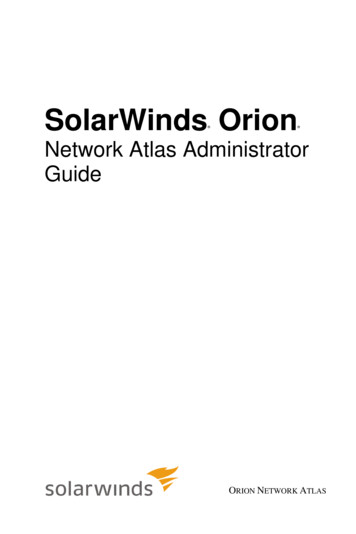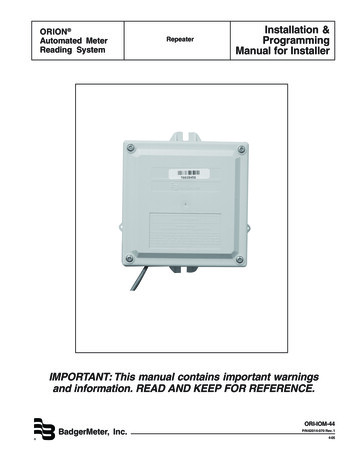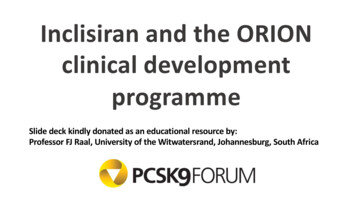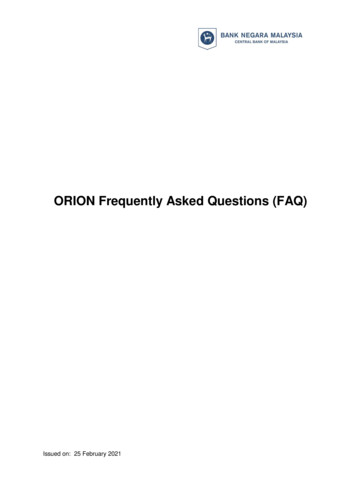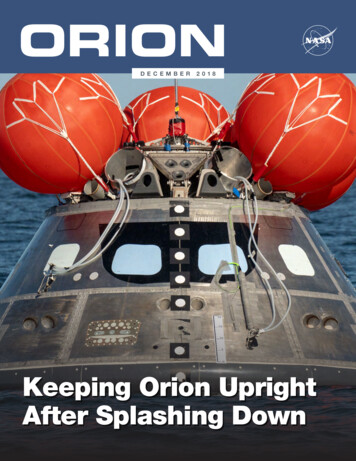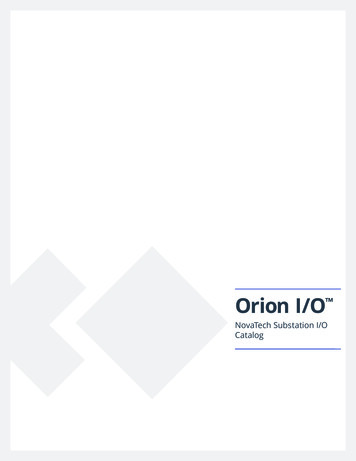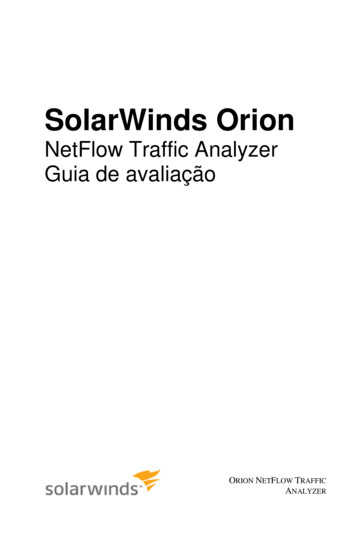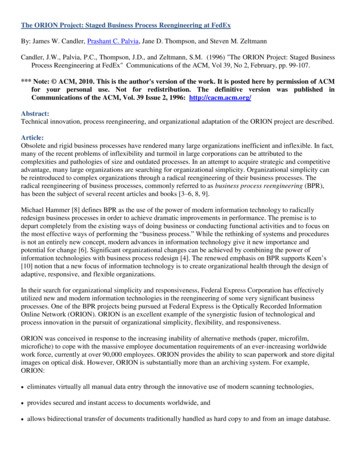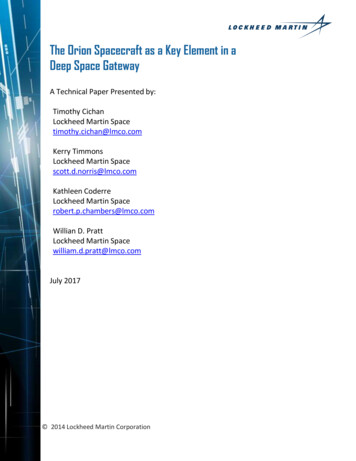
Transcription
The Orion Spacecraft as a Key Element in aDeep Space GatewayA Technical Paper Presented by:Timothy CichanLockheed Martin Spacetimothy.cichan@lmco.comKerry TimmonsLockheed Martin Spacescott.d.norris@lmco.comKathleen CoderreLockheed Martin Spacerobert.p.chambers@lmco.comWillian D. PrattLockheed Martin Spacewilliam.d.pratt@lmco.comJuly 2017 2014 Lockheed Martin Corporation
AbstractWith the Orion exploration vehicle and Space Launch System (SLS) approaching operationalstatus, NASA and the international community are developing the next generation of habitatsto serve as a deep space platform that will be the first of its kind, a cislunar Deep SpaceGateway (DSG). The DSG is evolvable, flexible, and modular. It would be positioned in thevicinity of the Moon and allow astronauts to demonstrate they can operate for months at atime well beyond Low Earth Orbit.Orion is the next generation human exploration spacecraft being developed by NASA. It isdesigned to perform deep space exploration missions, and is capable of carrying a crew of 4astronauts on independent free-flight missions up to 21 days, limited only by consumables.Because Orion meets the strict requirements for deep space flight environments (reentryconditions, deep-space communications, safety, radiation, and life support for example) it is akey element in a DSG and is more than just a transportation system. Orion has the capability toact as the command deck of any deep space piloted vehicle.To increase affordability and reduce the complexity and number of subsystem functions theearly DSG must be responsible for, the DSG can leverage these unique deep space qualificationsof Orion. For example, Orion already contains sleep stations, a galley, and a toilet. Therefore,the DSG would not need those functions especially in its early stages of buildup (at most, onemight choose to add two sleep stations to the habitat to increase personal space). This paperexplores in more detail the many ways in which Orion can use its advanced capabilities toaugment an early DSG, thereby decreasing complexity and improving affordability.I. IntroductionOrion is a highly capable vehicle with unique features designed to meet deep spaceenvironments and keep crew members safe even given dangerous emergency scenarios. Theinvestments made in Orion can be leveraged to reduce the cost, complexity and developmenttimeline for a Deep Space Gateway (DSG).With Orion operating as the command deck when crew is present, the DSG can be designed toa more affordable single fault tolerant architecture by utilizing the redundancy, performance,and safety built into Orion. Orion’s robust fault tolerant design and capable avionics systemenable it to provide the safe control and necessary interfaces for crew to interact with the DSG.Should an anomaly occur on the DSG, the crew can withdraw to Orion and use it as a safehaven while they continue to work to resolve the issue or safely return to Earth.As technology matures and new mission capabilities are required in cislunar space, Orion willbring new systems in the form of Mission Kits to increase the capabilities of the DSG. NASA’sgoal to extend human presence in deep space can be accomplished affordably by integratingthe existing investments in Orion with future development in the DSG.2
II. Deep Space GatewayNASA has outlined a phased approach to expand human presence deeper into the solar system,starting with the Moon. Phase 1 of this plan begins in the 2020s, with missions in cislunar spaceand assembly of the Deep Space Gateway (DSG).2 The DSG is a space platform in cislunar spacewhich can support crewed missions of 30 – 60 days in length, with increased duration eachmission. The DSG is comprised of several elements which provide key capabilities for cislunarexploration; a habitat where the crew would live and work, a self-sufficient power andpropulsion bus with docking capability, an extra-vehicular activity (EVA) element with an airlockfor spacewalks and storage, and a cargo/logistics pod for supplies and trash disposal.Lockheed Martin is currently working on a design of the DSG through the NASA fundedNextSTEP Habitat program. The Lockheed Martin DSG concept can be seen in Fig. 1. The HabitatElement (HE) provides the Orion crew with additional living space and contains the sciencestations which can be configured for specific missions. The Power and Propulsion Element (PPE)is the primary source of power, propulsion and breathable air and is attached to the HM. ThePPE is capable of operating autonomously for long periods of time while uncrewed and allowsOrion to control the DSG when astronauts are present, providing robust crew safety.The Extra Vehicular Activity (EVA) Element allows for the crew to exit for space walks andconsists of an airlock and equipment bay for spacesuit storage. The Robotic Arm is operatedfrom inside the HE and provides astronauts the ability to assist in docking procedures andperform extra vehicular operations without leaving the DSG (i.e. inspection and tending toexternal science experiments). The final element of the DSG is the cargo and logistics pod whichwill allow supplies to be brought to the DSG as well as trash disposal. The DSG is designed to berobust and configurable, allowing for international partners to contribute to on-board scienceexperiments or even major subsystems3.3
Figure 1. Lockheed Martin’s Phase 1 DSG in Cislunar SpaceIII. The Orion SpacecraftThe Orion Spacecraft is a key element in NASA’s human deep space exploration plans. NASA hasdesigned the human rated Orion to meet deep space requirements and ensure it is robust fromboth a reliability and availability perspective. It can carry up to 4 astronauts on missions up to21 days, limited only by consumables. During quiescent operations and/or while part of a largerarchitecture, Orion subsystems have the ability to support missions up to 1,000 days1. Orion iscurrently planning its next three test flights, Exploration Mission 1 (EM1), Ascent Abort 2(AA-2) and Exploration Mission 2 (EM-2). For more detailed information on the upcoming Orionmissions see reference4.Orion is comprised of three modules; the Crew Module (CM), the Service module (SM) which iscomposed of the European Service Module (ESM) and the Crew Module Adapter (CMA), andthe Launch Abort System (LAS). Orion will be launched on the Space Launch System (SLS). TheCM contains all the advanced subsystems to sustain a crew of four during deep space travel andprovides safe reentry to Earth from deep space. The ESM is provided by the European SpaceAgency (ESA) and provides the in space propulsion capability, generates power, radiates excessheat, and carries the consumables (water, oxygen and nitrogen) to sustain the crew.The CMA interfaces mechanically and electrically with the CM, and includes the separationmechanisms. The LAS protects the crew from the pre-launch, launch and ascent environmentsas well as provides the abort capability to remove the CM from any hazardous condition that4
may arise during these phases. The LAS also provides the propulsive capability for the LASjettison.Figure 2. The Orion Spacecraft ConfigurationIV. Orion as the Command Deck of the FutureThe most affordable way to send humans back to cislunar space in the near term is to leverageNASA’s investment in current systems and technologies. Orion is a fully human-rated spacecraftdesigned to meet the strict requirements of deep space environments and challenging ascentand reentry environments. Aspects of the avionics, crew interface, life support, power,communication, and navigation systems on Orion can be utilized early on in the buildup of theDSG, to minimize duplication and rework and also provide a safe environment for astronauts tolive and work. Using Orion as the command deck benefits the DSG without affecting Orionresource margins. This allows the DSG to become more independent in an evolutionary mannerthat aligns with affordability targets.A. Command and ControlCommand and Control of Orion was designed to cover critical functionality, availability andsafety to meet key performance requirements. There are four redundant Flight ControlModules (FCMs) within the two Vehicle Management Computers (VMCs), shown in Fig. 4, whichsurpass the reliability requirements and ensure availability as Orion transitions through thechallenging radiation environment of the Van Allen belts. As Orion prepares for reentry thevehicle transits through the Van Allen belts and the redundant FCMs are necessary to ensuresufficient radiation tolerance so that the crew is not waiting for computers to reboot whencritical events such as thruster and pyro firings should be occurring. The FCMs provide a highintegrity platform to house software applications, and have sufficient processing power toperform command and control of Orion as well as the Deep Space Gateway (DSG) without5
Figure 4. Orion Vehicle Management Computerhouses the Flight Control Modules that are thecommand source for the spacecraft.Figure 3. Critical systems from Orion are leveraged by the Deep Space Gateway.negatively impacting central processing unit utilizationmargins. Employing Orion as the command deck whendocked with DSG enables a more streamlined approachto the avionics on the DSG. The planetary spacecraftutilized in New Frontiers and Discovery missions are agood model for the uncrewed portions of the DSGmissions. The DSG command and data handling can bemore akin to a deep space planetary mission with asingle fault tolerant architecture because it relies on thereliability and availability built into Orion when crew ispresent. This allows DSG to work to similar cost andtimeline constraints as planetary missions whilemaintaining a safe environment for crew through Orion.Figure 4. Orion Vehicle ManagementComputer houses the Flight ControlModules that are the commandsource for the spacecraft and couldminimize computing needed on theDSG.The Orion Onboard Data Network (ODN) uses TimeTriggered Gigabit Ethernet (TT-GbE) to provide datatransfer within the vehicle as well as to interfacingvehicles. This is a triple redundant network capable ofmoving data at a rate 1,000 times faster than systems used on the shuttle and space station.This technology is built upon a reliable commercial data bus that has been hardened to beresilient to space radiation and proven on the Orion Exploration Flight Test-1 (EFT-1). The DSGwill interface directly to the ODN via standard Ethernet. The redundant nature of the ODN6
ensures that critical commands leave Orion accurately and that essential telemetry from theDSG Command and Data Handling Unit (CDHU) is routed appropriately once onboard Orion. Byselecting a standard Ethernet architecture, DSG is already compatible with NASA’s Orion.Critical elements in the avionics network architecture are shown in Fig. 5.In the unlikely event that something goes wrong with the primary flight computers on Orion, adissimilar processing platform with dissimilar flight software is hosted on the Vision ProcessingUnit (VPU). The VPU provides a hot backup function to the redundant FCMs during criticalphases of flight. This capability will also be utilized by astronauts aboard the DSG shouldemergencies arise in cislunar space.Orion employs a wireless communication system to interface with cameras used to monitorcritical events and crew activities. This system is capable of sending commands and receivingtelemetry from end systems and is connected to a utility network that interfaces with the ODN.With the use of portable tablets and the Orion wireless communication system, the crew hasflexibility to be in any area of the combined Orion/Deep Space Gateway and have insight intothe critical systems of the cislunar station while having the ability to act on any urgent caution,warning or emergency alerts.Figure 5. Significant Components in DSG Network ArchitectureB. Crew InterfacesThe Orion Displays and Control equipment is the crew interface to the Orion systems. TheDisplays and Controls consist of three Display Units, seven Switch Interface Panels, twoRotational Hand Controllers, two Translational Hand Controllers, and two Cursor ControlDevices, shown in Fig. 6. The Switch Panels and Hand Controllers hardware interfaces throughserial interfaces to the Power and Data Units (PDUs) and then via the ODN to either FCMswithin the VMC or the DUs for processing. The Display Units (DUs) utilize a variety of DisplayFormats to provide data to the crew for awareness and action when necessary.7
The Orion Displays and Controls are designed for an intensive amount of crew interaction bothin nominal and off-nominal scenarios. The Display Format Software Architecture enablesstreamlined addition of new formats via the Generic Display Engine; or, for more complexformats, via a library of reusable and common graphical elements. This library of graphicalelements can be leveraged to facilitate development of unique formats for the DSG. The DSGformats will be displayed on the Orion DUs, a display within the habitat, or the supplementalwireless tablet. The DSG Display Formats allow the crew to interact with the DSG and provideinsight into the health and status of the DSG systems.Electronic Procedures have been developed for Orion that allow direct interaction with theDisplay Formats enabling reduced workload on the crew. The Electronic Procedures efficientlystep the crew through planned tasks and reduce crew workload by highlighting varioustelemetry on a Display Format or queuing up commands. Additionally, the ElectronicProcedures have built in links to the onboard Caution & Warning System which alert the crewwhen onboard faults and anomalies occur. The Electronic Procedures link provides the abilityfor the crew to bring up Electronic Procedures which communicate the urgent actions the crewneed to take in order to address the Caution & Warning condition. This same methodology willbe employed on the DSG to allow the crew more time for performing science and roboticmissions by minimizing maintenance and sustainment tasks on the DSG. Utilizing a DCM withinthe habitat and similar display technology allows for seamless integration with the Oriondisplays and familiarity for the crew for operations.C. PowerThe Orion power system is capable of generating and supplying more power than is requiredfor its on-orbit operations and surplus power can be shared with the DSG to supplement crewsurvival equipment and science experiments. Because Orion power margins are a criticalresource, the DSG also supplements the Orion power with the PPE solar panels. The four Orionsolar arrays generate about 11kW of power and spread 62 feet when extended. Orion’sbatteries use small cell packaging technology to ensure crew safety when providing 120V powerto the many systems on Orion.Power is transferred between the solar arrays and batteries and to the end item loads via thePower and Data Units (PDU), shown in Fig. 7. This technology is leveraged to ensure a safeenvironment while the crew is onboard the DSG as well. The DSG power system is designed tosupport hardware that needs to be operational at all8
Figure 6. Flexible Display Formats and electronic procedures enable extensive crew interactionwith the Orion spacecraft.times and crew specific items within thehabitat such as life support systems andmission specific science experiments will usesupplemental power from Orion.D. CommunicationsThe DSG communications architecture will alsoleverage the Orion S-Band architecture byutilizing similar components. The Orion PhasedArray Antennas (PAAs) can be used todownlink telemetry from the DSG to the DeepSpace Network (DSN) while Orion and DSG areFigure 7. Power distribution, effector controldocked. The science and video data collectedoutputs, and general input/output isby the DSG is most efficiently downlinked using accomplished with distributed Orion PowerOrion’s optical communication system. Opticaland Data Units which could also be used oncommunication enables a significant increasethe DSG to minimize new development.to downlink bandwidth capability compared totraditional radio frequency (RF) communication, for example NASA's Lunar Laser9
Communication Demonstration (LLCD) demonstrated a record breaking moon to Earthdownload rate of 622 Mbps5.E. Guidance, Navigation and ControlOrion’s Guidance, Navigation and Control (GN&C) system will be utilized to minimize the costand complexity of the DSG. During docking operations, the DSG will be the passive vehicle andOrion will use its Vision Navigation Sensor and Docking Camera to perform the pilotedoperations. Locating these sensors on Orion allows for use of Orion’s fully redundant systemsand software architecture with robust control algorithms without having to fully duplicate thisfunction on the DSG. During mated operations, Orion will control the attitude of the matedstack using thrusters. Orion’s propulsion system has sufficient fuel for station keeping of themated stack; and, as elements are added to the DSG, the large inertias are more easilymanaged via thruster control than with reaction wheels. Orion has adequate control authorityto meet mission needs for maneuvering and inertial hold.F. Environmental Control and Life Support SystemsThere is a symbiotic relationship between Orion’s Environmental Control and Life SupportSystems (ECLSS) and what is needed on the DSG. These systems are designed to maintain acomfortable environment for four crewmembers for both short-sleeve cabin operations as wellas suited operations under a variety of challenging external environments. It maintains a fullycontrolled cabin atmosphere and living environment while the crew performs their low-Earthand cislunar exploration missions.Additionally, it is robustly designed to sustain critical functions for returning the crew safelyhome after a failure or catastrophic event, such as a toxic contamination or fire event or abreach in the pressurized cabin vessel. While the Orion ECLSS is designed for a referencemission of 21 days, the capabilities may be extended further when augmented with additionalconsumables and minimal equipment on the DSG to sustain the larger volume. Combined witha flexible layout configuration that utilizes standardized interfaces on the DSG, this approachallows for the streamlined implementation of an affordable and timely initial DSG capabilitythat anticipates growth on the DSG as it transitions to a self-sufficient capability.The Orion Air Revitalization System (ARS) is responsible for providing adequate ventilation forthe crew, maintaining carbon dioxide, humidity, and trace contaminant concentrations atcomfortable and safe levels, and maintaining the temperature at the desired crew selectedsetpoint. It includes two different types of fan packages, each redundant, that are optimizedover a range of operating points.Multiple heat exchangers remove heat from the air and transfer it to the Thermal ControlSystem (TCS). A regenerative system continuously removes carbon dioxide and humidity, whilea high efficiency particulate filtration system removes dust, fungi, and microbes from the air.Air monitoring ensures critical gases are within safe parameters and a suite of emergency10
equipment protects against fire and toxic contamination vents. The system accommodates forboth low (sleep) and highly active (exercise) periods for the full four crew compliment. As such,many of these components are already sized to handle the DSG crew as-is or may be minimallyduplicated within the DSG to accommodate the extended volume and mission requirements.The Orion ARS is the limited by the consumable based trace contaminant control system; thus,the DSG would retain that critical function to preserve the Orion capability.The Orion TCS consists of both an active coolant network and passive heaters and insulation toprotect the internal thermal environment from the extreme external temperatures and tocollect and reject heat from internal components like avionics equipment. The TCS is sized for ahigh heat load capacity and utilizes both radiators and a regenerative Phase Change Material(PCM) heat exchanger to accommodate peaks of high thermal loads without relying on the useof expendable consumables. By leveraging Orion’s capabilities and initially minimizing theinternal components on the DSG, the DSG TCS can be simplified to primarily passive thermalcontrol while scarring for an active coolant network. As the DSG architecture evolves incomplexity and mission duration requiring more standalone capability, it can be upgraded withan active thermal control system as needed. Further, many of the same components andcoolant fluids used on Orion can be implemented on the DSG for commonality.The Orion Potable Water System (PWS) is a simple system of a pressurized storage tank watersupply that is distributed to the crew for drinking and food rehydration via a water dispenser.The water dispenser is designed to be compact and modular, which allows for the option toupgrade with an adapter kit to interface it with water storage bags provided by the DSG. Thisoffers mass and volume savings of water storage tanks, pressurant tanks, and avoids theduplication of a water dispenser on the DSG.The Orion Waste Management System (WMS) features a full commode suitable for short tomid-length duration missions, offering both privacy and comfortable means for the astronautsto use the bathroom. It employs a small urine tank that is vented to space and replaceablecanisters for solid waste storage. By utilizing Orion’s WMS, the DSG only needs to provide theadditional consumable materials for the extended mission duration while saving valuable massand habitable volume. Additionally, there is potential flexibility to recover urine from the tankand store in bags for future processing as the DSG architecture evolves to include moreadvanced closed-loop ECLSS hardware.V. Orion as a Safe Haven to the DSGA facility placed in an orbit in the vicinity of the Moon is an ideal place to gain experienceoperating in deep space. To undertake human missions further into space, humans need todevelop the technology, systems and capabilities required to live in deep space for extendeddurations. Employing a space proven Orion allows for a safe, practical approach to incrementalbuild-up of capabilities on the DSG.11
Orion is already designed to meet deep space requirements including the redundancy requiredfor human-rating and ability to withstand radiation events. The reliability of the DSG increaseswhen Orion is docked because Orion brings its quad redundant flight computers, tripleredundant network and fault management software. This robust avionics architecture offersthe necessary redundancy to ensure reliability and availability of the critical systems requiredwhen crew is present. In early missions to the DSG, the crew must perform many activities toadvance human capabilities in deep space such as technology maturation of regenerative lifesupport systems, practice tele-operation of rovers, and normal operations practice withsimulated communications delays.3In the event that an anomaly or emergency scenario occurs on the DSG, the crew can sequesterthemselves in Orion. The ECLS system on Orion offers commodities for crew survival which issignificant in the event that Orion is acting as a safe haven while the crew troubleshoots anyproblems on the DSG. Orion also has the capability for crew to perform contingency EVAs fromthe crew module, which allows for more flexibility in troubleshooting scenarios. If thoseproblems can’t be resolved with crew onboard, the mission can be aborted and Orion will bringthem back to Earth safely.The ground can also continue to work to resolve the DSG anomaly remotely. There areuncertainties associated with the new techniques, technologies, and protocols needed deepspace human explorations and the ideal location for gaining this knowledge is the space in thevicinity of Earth’s moon, in cislunar space. It provides many of the hazards found in deep spaceand near Mars, while still being days, not months, from the safety of Earth. Fig. 8 highlightsOrion as an element of the architecture of both the DSG and Lockheed Martin’s Mars BaseCamp (MBC) and how Orion serves as a safe haven capability for missions to cislunar space andMars.VI. Orion Enables an Evolvable Exploration ArchitectureUtilizing Orion as part of the initial DSG architecture enables near term flight while allowing foran evolutionary path to a more self-sufficient Gateway. NASA has invested in Orion Systemsthat have surplus capability in many areas, from computer processing to system power to lifesupport. Leveraging that excess capacity permits the creation of a leaner DSG in a shorterperiod of time. Continuity of human spaceflight is a key strategic principle in NASA’sarchitecture for deep space exploration, and it is achievable when all elements of NASA’s pastinvestment are utilized to their maximum capacity. Over time and through subsequent missionsthat add key elements to enhance the DSG, its reliance on Orion can decrease as it becomesable to safely and independently support human missions. The evolution of the DSG towardsthe Deep Space Transport (DST) and Mars missions is shown in Fig. 9.Orion provides the ability to transfer both pressurized and unpressurized cargo to orbit. Thisfeature enables an evolutionary approach to the DSG through the use of Mission Kits. Byleveraging the advanced systems and cargo capacity on Orion it is possible to fly an affordable12
DSG earlier and add to its capabilities over time. Additionally, Orion has the capability to ferrycargo pods to the DSG that can be left behind or swapped out to enhance functionality, such asthe ECLS system, in cislunar space. On early missions to the DSG, Orion’s pressure swing aminebeds are operational during docked operations and therefore reduce the load required for theDSG to handle. This translates to less hardware being flown on the early DSG missions; therebyreducing weight and cost of the initial DSG. As closed loop ECLS technologies mature, anadvanced ECLS module can be flown aboard Orion as a Mission Kit to the DSG or within a cargopod. This upgraded, stand-alone ECLS would remove the burden from a docked Orion toprovide life support to the DSG crew. Another example of utilizing cargo pods to upgrade theDSG is the robotic arm. The robotic arm will be used to expand the DSG robotic capability forberthing, inspection, and maintenance tasks. By enabling an evolutionary path, Orion is anessential component in ensuring an affordable and near term launch of DSG.Figure 8. Orion provides safe haven capability for the DSG and MBC.As the DSG evolves, new capabilities are refined which are directly applicable to a DST for aMars mission. Orion is key to this evolution and for a future deep space vehicle such as NASA’sDST or Lockheed Martin’s concept for the DST, MBC. For more on Lockheed Martin’s MBCconcept please see reference [1, 7] for the MBC Architecture. Orion is architected for longduration missions and can act as the Command Deck for the DST. The redundancy androbustness built in to the Orion avionics is leveraged to ensure crew safety whether in a moonorbit or at Mars. The same avionics hardware that Orion uses is easily integrated into a DSTbecause of the network architecture that is the backbone of the Orion avionics.13
The crew interface to the spacecraft will mimic what has been done on Orion through commonDisplay Formats to give the crew members a familiar experience and reduce the amount of newtraining required. New Display Formats will be added that are specific to the Mars vehicle, it’sassociated hardware, and unique procedures that the crew need to run for Mars missions;however, the feel and use of the displays will be no different from what the crew used on DSG.The DSG also acts as a testbed to mature advanced ECLS technologies.Orion currently operates as an open loop system, but the spacecraft that go to Mars will needto act as a closed loop ECLS system recycling and regenerating consumables such as oxygen andwater. The DSG will evolve from an open loop system to a closed loop system via the additionof mission kits allowing astronauts to experiment and gain data on these new technologies thatwill flow into the design and implementation of closed loop systems installed on the DST.The power and propulsion systems are another area where there is direct translation from thetechnologies used on DSG to what is needed for DST. Solar Electric Propulsion (SEP) is a lowFigure 9. DSG capabilities are enhanced with each mission and evolve to become MarsBase Camp14
thrust, highly efficient method for space transportation that will be employed by both DSG andDST. The DSG solar arrays are sized to support the electric energy required by the Hall CurrentThrusters utilized in the SEP system. Humans will gain experience with a SEP system by usingthis technology to transport elements from LEO to cislunar space and while at the moon tomove between different orbits. This technology is required for Mars missions to minimize theamount of fuel needed to transit between the moon and Mars to make mass available for otherrequired logistics. The experience gained from living and working in cislunar space will beinvaluable for the design and development of the systems needed for Mars missions.VII. ConclusionLeveraging NASA’s investment in Orion minimizes development time and cost for the DSG. TheDSG operates the majority of the time without crew presence which makes the planetaryspacecraft utilized in New Horizon and Discovery missions a good model for this application.The DSG can follow the single fault tolerant architectures employed on planetary missions andwork to similar cost and timeline constraints while creating a safe environment for crew byrelying on the safety and reli
investments made in Orion can be leveraged to reduce the cost, complexity and development timeline for a Deep Space Gateway (DSG). With Orion operating as the command deck when crew is present, the DSG can be designed to a more affordable single fault tolerant architecture by utilizing the redundancy, performance, and safety built into Orion.


